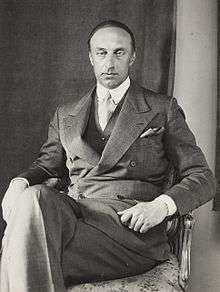G. A. Gripenberg

Georg Achates Gripenberg (18 May 1890 – 31 May 1975) was a Finnish diplomat.[1] He served as an Envoy of Finland to London in 1933–1941 and in Stockholm from 1943 to 1956 and the first Ambassador to the United Nations from 1956 to 1958.
G.A. Gripenberg was born in Saint Petersburg, Russia. He belonged to Gripenberg noble family, and his father was a senior civil servant of independence activism, the real State Councilor Alexis Gripenberg[2] His mother was Agnes Maria Fredrika von Haartman, a member of von Haartman noble family.
Gripenberg wrote his matriculation examination in 1907 from Gymnasiet Lärkan from Helsinki and graduated as a Bachelor of Philosophy from the University of Helsinki in 1911 and as a bachelor of law from the Uppsala University in Sweden in 1917. In 1908–1909 he also studied at Oxford University and London School of Economics in England.[1]
When Alexis Gripenberg was appointed in January 1918 as Finland's first diplomatic representative to Sweden, G. A. Gripenberg acted as a private secretary to his father for a while before moving to Finland to join the civil war in the White Guard.[3]
Gripenberg was hired in Finland's newly established Ministry for Foreign Affairs Department in 1918. He was initially a secretary of the Ministry of Foreign Affairs, but resigned the following year. In 1920 he was recruited back to the ministry's office as Permanent Secretary. Because of the lack of qualified diplomats at that time, he quickly became a foreign minister.
Gripenberg initially served as Chargé d'Affaires in 1921–1923 in Brussels and The Hague, 1923–1929 as Chargé d'Affaires in Madrid and Lisbon, and in 1929–1933 as Envoy to Buenos Aires and Rio de Janeiro (1931–1933 also in Santiago de Chile).[1]
In 1933, Gripenberg was appointed Envoy to London, Finland's most important representation. His term there lasted until the diplomatic relations between United Kingdom and Finland broke during the Continuation War following the British war declaration at the end of 1941.
Gripenberg was in non-active status in Finland and was named a Finnish representative for the Holy See in the autumn of 1942, but the following spring he was transferred to Stockholm. It was, at thet time, the most important foreign mission in Finland, especially because the Soviet Union had decided to conduct peace talks with Finland via Stockholm via the end of the war.
Gripenberg generally avoided political influence, but was in the middle of peace inquiries because of his position.[1] He continued in his place after more than a decade of war and especially President J. K. Paasikivi appreciated his qualifications. For the last two years in Stockholm, 1954–1956, he served under the title of Ambassador.[3]
After Stockholm, Gripenberg was still in Finland from the beginning of April 1956 until the end of 1958 as Finland's first ambassador to the United Nations, after which he retired. Gripenberg received many high-end domestic and foreign decorations and wrote several extensive memoirs during his pension years.[1] He died in Helsinki.